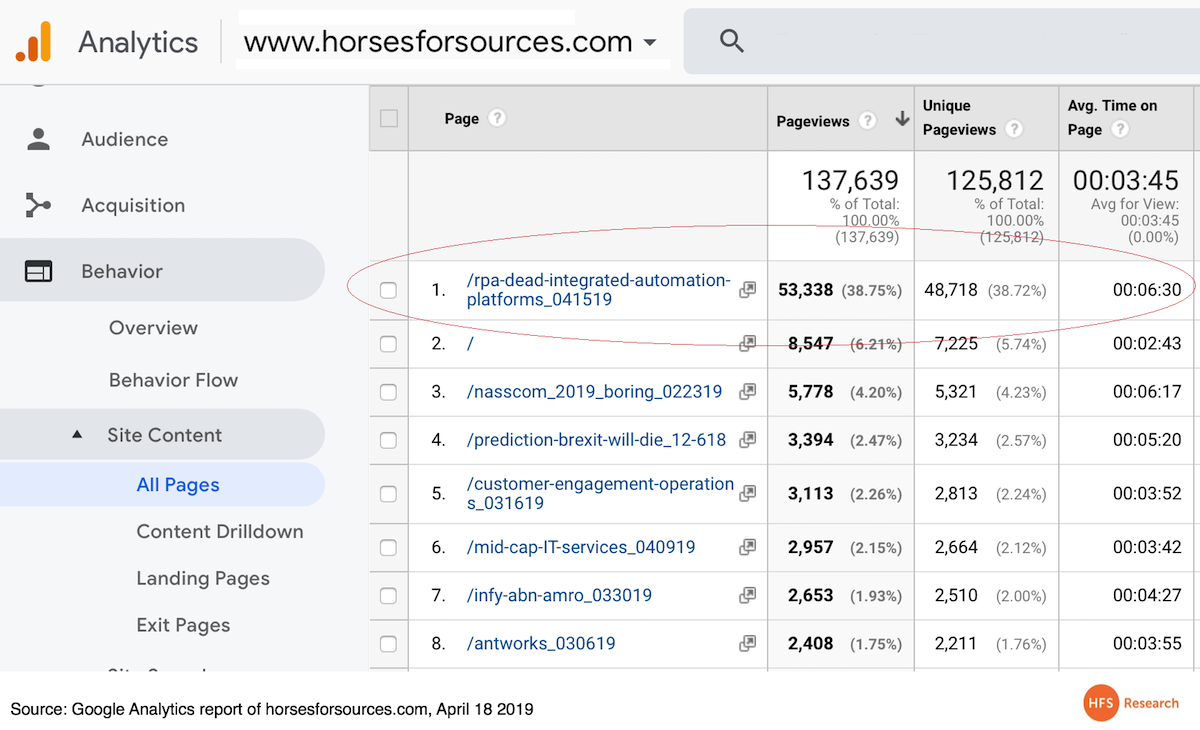Well, you can’t beat a good headline, and you really can’t beat it when 50,000 people read the “RPA is dead. Long live Integrated Automation Platforms” blog article in just 48 hours, spending a whopping average of 6.5 minutes actually reading it. Yes, most of you made it further than the headline!
For those of you familiar with google analytics, I thought I would take the unique step of actually sharing some readership stats from our blog this week, just to show you how the extent of impact our plea to the industry is having to “wake up to enterprise integration and stop festering in obscure RPA”:
So where do we all go from here?
RPA as a term just doesn’t make sense anymore, but these terrific brands will thrive as Robotic Transformation Software. We re-badge RPA as Robotic Transformation Software (RTS) because that’s what it is (or what aspires to be). Only a small portion of “RPA” is actually “process automation”… most of it is desktop apps, screen scrapes and document management fixes. Most “RPA” engagements that have been signed are not for unattended processes, instead, most are attended robotic desktop automation (RDA) deployments. Attended RDA requires a loop of human and bot interplay to complete tasks. These engagements are not the pure form of RPA that we invented back in 2012 – they are a motley crew of scripts and macros applying band-aids to messy desktop applications and processes to maintain the same old way of doing things.
Integrated Automation Platforms are the Holy Automation Grail (HAG*) if we can make it there. Automation ultimately needs to support transformation, not legacy. The more these RTS tools can be leveraged by clients – not only to do things better and more automatically – but also to help them re-wire their operations to achieve their outcomes, then we have lift-off. These tools also need to make enterprises more agile – if you just work on steady-state fixes without focusing on how to make real changes down the road, we will see many enterprises stuck in legacy purgatory, unable to switch out bots in the future.
*HAG is not an official acronym, I just made it up. Peace out robo-warriors ✌
Posted in : Artificial Intelligence, enterprise-integration-platforms, Robotic Process Automation, robotic-transformation-software







Good job Phil, the second check is in the mail for trashing RPA during Automation Anywhere so Conference!
RPA has always been automating the “as is”, not the “want to be”. Whether it’s front office with RDA or Back office with RPA or a mix of the two (Agile RPA). 15 years this month I’ve been selling it to 1000’s of clients. Millions of task automations in RDA, deployed into 100’s of thousands of RPA attended bots really do deliver a quicker and greater scale of RPA. It automates the blindingly obvious manual work to deliver faster customer service, reduce call times and greater accuracy. I go as far to say with RDA that if you can’t clearly see the ROI before you start, you shouldn’t even start.
But for all RPA/RDA “success” or “failure”, what to you do next year? If it’s not more RPA because what’s left is too hard (or wrong) to screen scrape against, then what is it? Excel Macros part 2?
I believe business and IT can no longer fight their misalignment in tactical v strategic automation. I believe in DPA (I think is aligning with Intelligent Automation and “Integrated Automation”) to deliver the Holy Grail of Automation with low-code / no-code application re-development and AI at it’s heard.
Phil
I would suggest that there are five enterprise software categories that are coming together to creat the Integrated Automation Platform:
RPA
BPM
EAI
Analytics/document processing
Low code/No code form and app builders
You need all five of these technology categories to make a complete automation platform. It will be interesting to see how vendors like Pega (looking at you Frances) or Automation Anywhere continue to evolve and build or buy the missing parts of their stack. Also interesting to see how cloud vs on premise develops.
Great perspective Phil Fersht and couldn’t agree more with Francis Carden Organizations desiring long lasting and high impact transformation need to think well beyond task automation (with either RPA or RDA bots) which is a path of diminishing returns. All you need to do is look at data suggesting the amount of failed RPA programs already on the books or the shockingly low numbers of actual deployed bots after major investments. Thanks both for the post.
Phil,
Congratulations for having the courage to call it like it is! There is not a single industry report, be it Gartner, IDG or Forrester or the likes, that has dared to shine the light on truth. There are so many products out there that claim many things; Intelligent Automation, Cognitive Intelligence, Integrated Automation and so on. Most of all of them are conclusively lacking in evidence in their current products and the roadmaps they have to show for the future. This is protected by the incestuous nexus between Platform / Product Developers and Corporate Investors. It is only now that they are realizing the term “Platform” being applicable to them to be relevant. Their businesses are yet to figure out its actualization; and given their state of agility and availability of resources can be at least 3 – 5 years from now. So there it is, it is blogs like this that can catalyze the transformers to transform the landscape of enterprises to become more intelligent and automated by created the right mechanisms to operate processes across an ecoystem!
The Key Message “AUTOMATION NEEDS TO SUPPORT TRANSFORMATION, NOT LEGACY” needs to to be looped recursively till it burns a hole in those who can actually make a difference.
Subbu